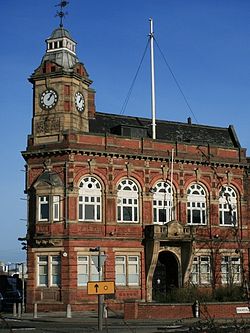Thornaby-on-Tees
| Thornaby-on-Tees | |
|---|---|
 Thornaby Town Hall |
|
| Thornaby-on-Tees shown within North Yorkshire | |
| Population | 24,741 (2011) |
| OS grid reference | NZ450180 |
| Unitary authority |
|
| Ceremonial county | |
| Region | |
| Country | England |
| Sovereign state | United Kingdom |
| Post town | STOCKTON-ON-TEES |
| Postcode district | TS17 |
| Dialling code | 01642 |
| Police | Cleveland |
| Fire | Cleveland |
| Ambulance | North East |
| EU Parliament | North East England |
| UK Parliament |
|
Thornaby-on-Tees is a royal charter town, civil parish and former borough within the in the ceremonial county of North Yorkshire, England. It is on the south bank of the River Tees, 3 miles (5 kilometres) southeast of and 4 mi (6 km) southwest of Middlesbrough. It has a population of 24,741 according to the 2011 census.
The name Thornaby came into existence about 800 AD when the land was given by Halfdene (Halfdan Ragnarsson), King of the Danes, to Thormod, one of his noblemen, hence "Thormods-by" – Thormod's farmstead. Although the -by suffix originally meant a farmstead, many of these grew into villages, taking the -by suffix with them in their names as with other villages in the area such as Danby, Faceby, Ingleby, Maltby and Ormesby.
There are other signs of Thornaby being a much older settlement. Traces of prehistoric man have been found, the earliest being a stone axe, 8 inches long, dating back to the Mesolithic Period (about 3000 BC). In 1926, a dugout canoe said to date from about 1600 – 1400 BC was found in the mud under 8 feet (2.4 metres) of water opposite Thornaby High Wood. An arrowhead of the Neolithic Period (about 3000 BC) was found in a garden on Thornaby Village Green.
During the Battle of Hastings (1066), one of William the Conqueror's noblemen, Robert I de Brus, marched north with a garrison of men and occupied the area of Cleveland. William gave him those lands to control including Thornaby and Middlesbrough.
...
Wikipedia

